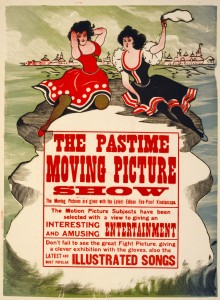(The following is an article from the September-October 2012 issue of the Library’s new magazine, LCM, highlighting 100 years of Copyright law.)
By Wendi A. Maloney
A hundred years ago, a new category of work became subject to copyright protection: motion pictures. The Townsend Amendment to the U.S. copyright law took effect Aug. 24, 1912, creating one class for dramatic motion pictures and one class for newsreels and similar material.
A May 1912 House of Representatives report explained:
The production of … motion pictures … has become a business of vast proportions. The money therein invested is so great and the property rights so valuable that the committee is of the opinion that the copyright law ought to be so amended as to give to them distinct and definite recognition and protection.”
At the urging of the movie industry, the amendment also limited statutory damages that could be awarded against movie studios for innocent infringement of nondramatic works.
The first year the Copyright Office accepted motion-picture applications, it registered 892 movies. One of the earliest was “The Charge of the Light Brigade” registered by famed inventor Thomas Edison on Sept. 26, 1912.
Edison was a prolific filmmaker whose studio produced movies on diverse topics for many years. In 1894, his firm registered “Edison Kinetoscopic Record of a Sneeze,” the earliest surviving motion picture deposited with the Copyright Office. The deposit consisted of a series of still photographs printed on photographic paper.

This 1894 image consists of a series of 45 frames for Edison's kinetoscopic movie showing a man, Fred Ott, sneezing. / Prints and Photographs Division
Before inclusion of motion pictures in the copyright law, copyright owners typically registered their movies as a collection of still photographs, which the law had covered since 1865. More than 3,000 paper copies of films in that format were deposited with the Copyright Office. Many of these early films—transferred to film stock in the 1950s—are now accessible in the Library’s collections.
After 1912, copyright owners started to deposit film. Because most film at that time was made on flammable nitrate stock, the Library chose not to house it. Instead, film deposits were returned to claimants, and the Library retained only descriptive material. This practice changed in 1942 when, recognizing the importance of motion pictures to the historical record, the Library began to request the return of selected works, including films made before 1942.
Nitrate film was phased out of production in 1951, replaced by nonflammable “safety stock.” The Library’s collection of nitrate film is now substantial, thanks mostly to donations from movie studios, said Mike Mashon, head of the moving-image section of the Motion Picture, Broadcasting, and Recorded Sound Division. Other donations have come from individual collectors and estates, including that of Edison.
As donations arrive, staff at the Library’s film-preservation laboratory in Culpeper, Va, make copies on safety stock. “We’re still acquiring nitrate films today,” Mashon said. “Gaps exist, but our collection effort has been quite successful.”
Download the September-October 2012 issue of the LCM in its entirety here. You can also view the archives of the Library’s former publication from 1993 to 2011.
MORE INFORMATION
Learn more about Edison and his work
Visit the Motion Picture, Broadcast and Recorded Sound Division
View “Edison Kinetoscopic Record of a Sneeze”

